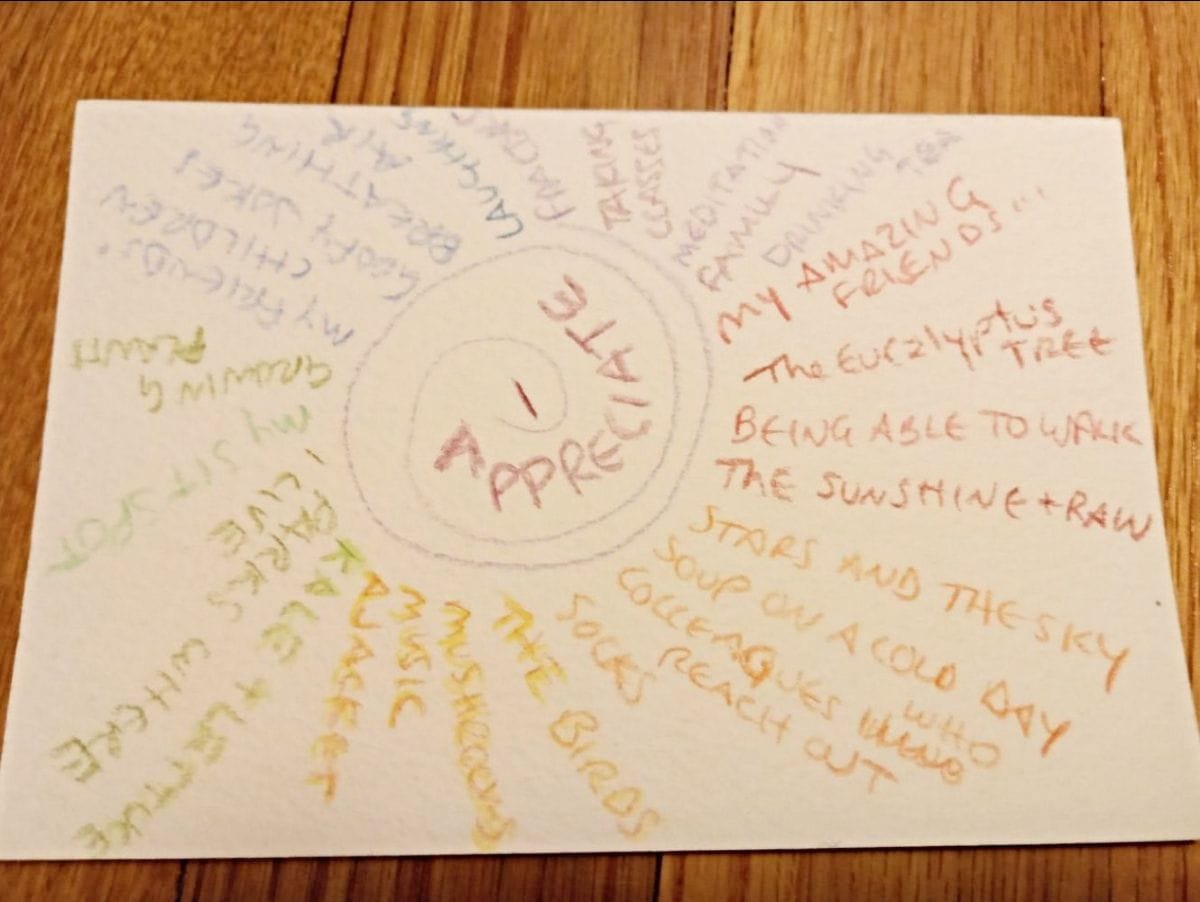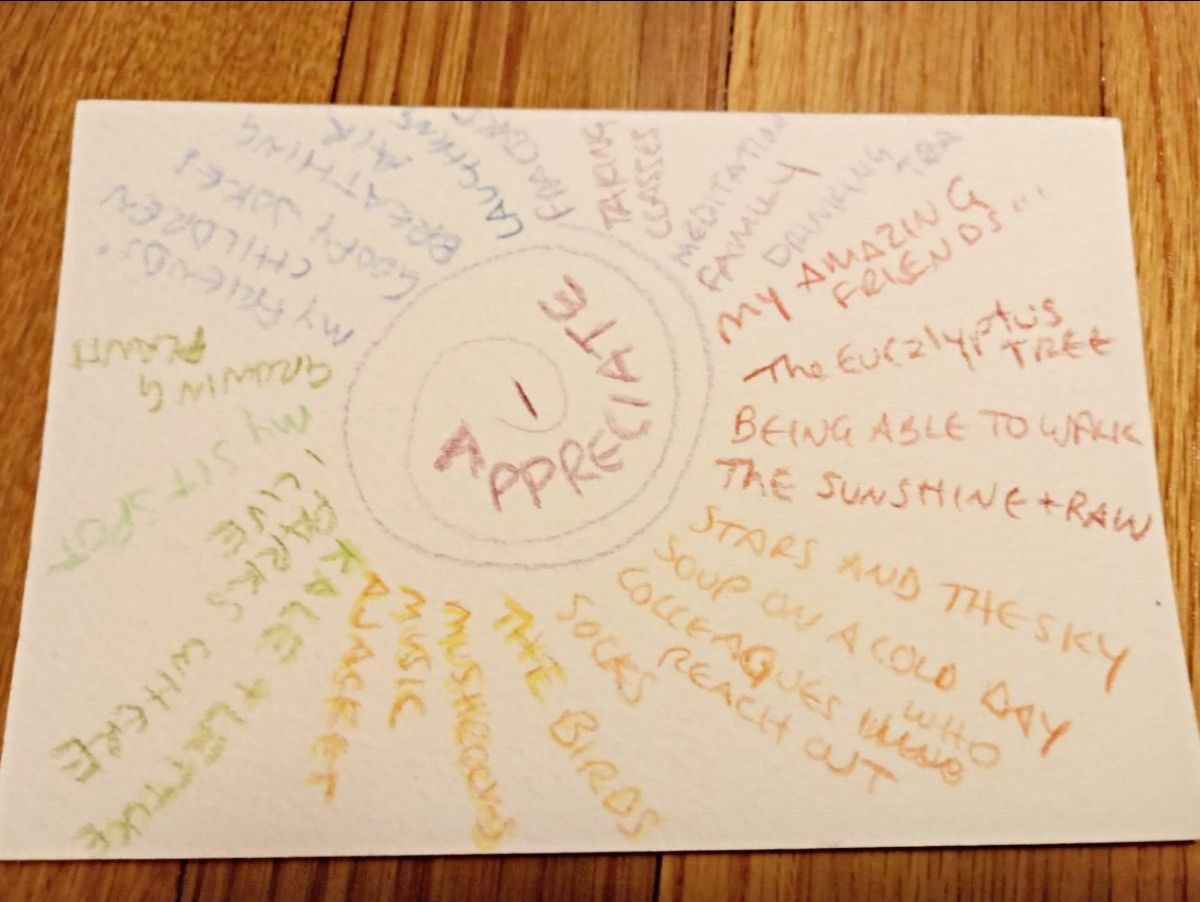Moment of Mind November 2019


Moment of Mind
Appreciation as a Practice and State of Being
In mindfulness we're using our attention to notice our moment to moment experience and then, when we see our minds judge or analyze, we acknowledge and let it go, returning to the present. It's a practice and it's also a state of presence we find ourselves in.
Gratitude, or when we appreciate something we value in our life, is also a practice and an innate state. You may notice that appreciation bubbles up at random times. The sigh of relief when you get some place on time, the "yes!" moment when there's not a line, the smiles of thank you when you are treated kindly in a service exchange, someone holding the door open when your arms are full, and even the swell of feeling supported when a friend calls...just when you needed it. This is you experiencing appreciation in the moment, as it emerges within you. You can also cultivate it as a practice.
I invite you to try any one of these gratitude practices out, or design your own this week!
- Small Stretch - Set a timer for 2 minutes and write down anything that comes to mind that you truly appreciate. If your mind goes empty, you could try rotating through categories such as shelter, food, people, etc.
- Medium Stretch - Write a letter, that you are able to give to someone or not, thanking the person for any and all of the ways you appreciate them or are grateful for knowing them. It doesn't have to be long. Here is an activity written for students as a framework (I like templates).
- Longer Stretch - onger Stretch - Give yourself about 15 minutes to explore an area that is a medium level challenge that occurred in the past and is now over from the lens of appreciation by answering the following questions. What supported me in that experience, however small or underestimated? What did I learn about my capacity and resilience in that experience? Write down whatever comes to mind, without trying to write with grammar or punctuation or complete sentences (or even readability).
In any of these activities you can practice being with the sensations and feelings that emerge. See what you notice and as you give your attention to what shows up you can befriend yourself - support your body as a mentor or friend would. I look at some of the research on this topic in the next section.
Love For Your Inner Science Nerd
Gratitude Writing and Mental Health
Gratitude practices are part of the field of positive psychology focused on subjective experiences of "optimal" human functioning. Researchers explore the variety of conditions when we say we feel at our best. Practices within this field are often used by therapists to help clients participate more fully in their own recovery as a supplement, or an "add on". Like mindfulness, many of the practices can be done by individuals on their own.
In a 2018 study, college students who were currently receiving mental health therapy were randomly assigned to one of three different groups. One group kept on with regular therapy sessions with nothing added (the "control" that the other groups were compared to). The second group went to therapy and completed gratitude writing exercises expressing gratitude to people in their lives. The third group went to therapy and completed expressive writing exercises focused on exploring thoughts and feelings about current stress. Expressive writing is another well researched element that is a bit like blurting all the thoughts in your head onto the page without editing - just a free flow of thought.
The group who used the gratitude activities "reported significantly better mental health than those in the expressive and control conditions" at both 4 weeks in and at the 12 week mark when the research was over. There weren't significant differences between people in the expressive and control conditions. The researchers also found from doing an analysis of the writing that there were lower proportions of negative emotion words and this seemed to influence the mental health outcomes.
A caveat about expressive writing: I shred my papers afterwards and find this most supportive of my mental well being. The point for me has been about letting stuff out and not holding onto it. I'm able to let self-censorship and self-criticism go because no one is looking at it.
It is helpful to see that gratitude is effective at supporting well being beyond therapy alone. This study was limited in scope (293 people, 65% female identifying, 21% people of color identifying and college age). More work to be done here and it's still useful to see research among a group with measurable mental health distress.
Part of what is happening relates to brain functioning. Last month's newsletter touched on "Neuroplasticity" or the brain's ability to change, adapt, and grow throughout life when given training inputs. Your neural networks are how different parts of your brain talk to each other and send/receive signals through nerves into, and back from, your body. These networks are responsible for generating what you perceive as memory, thought, sensations, and feelings. It's how your brain generates your internal experience of the outer world.
There is a popular saying in brain science that "what wires together, fires together." The idea here is that each time our brain generates a set of signals along neural connections this reinforces those connections. The brain can also build new neural connections with new inputs.
So, in any mindfulness practice when you spend more time practicing directing your attention in specific ways this grows your brain's capacity to do this more frequently and for longer periods of time. This is you intentionally sending signals to the brain to generate these states more often. You are shaping your internal model of the world with these practices.
Gratitude is a bit like adding in doses of "notice what's going well" in almost a counterbalance to the brain's capacity to be on the lookout for what is not going well. It also supports your stress recovery physiology, which is a topic for another day.
From the Bookshelf: An Indigenous Peoples' History of the United States
Part of my appreciation of mindfulness is learning how to be with challenging feelings. Hiding from difficult feelings often means hiding from real world events. Feeling empathy is one way we can support one another and take collective action for change.
As a person who provides nature-based mindfulness walks, it's important to me that I understand the history of the land where I live. I also seek out history told by voices from groups who have been marginalized by dominant society because these stories are hidden and important. Since the history of how the U.S. developed the national ritual we now call Thanksgiving is steeped in half-truths, this month I'm reviewing a book related to both land and indigenous communities.
One of my friends gifted Roxanne Dunbar-Ortiz's well-researched book "An Indigenous Peoples' History of the United States" to me several years ago at a friendsgiving. It is an eye opener to put it mildly. It fills in many gaps of what is left out of common narratives and textbooks written from European settler perspectives about how the U.S. became the country it is today. The book reveals the richness and sheer size of the multitudes of indigenous populations that lived throughout the Americas before colonists arrived as well as their ongoing attempts to defend themselves.
This book is challenging in a good way. It turns mythology of the "savage" indigenous stereotype and the "honorable" colonial founder stereotype upside down. It also reveals the ongoing, unrelenting brutality and genocidal techniques that waves of settlers used to attempt to end the "Indian problem."
I invite you to read this slowly and consider exploring the youth version. If I have one criticism it's simply that there is so much ground to cover in understanding colonial-settler mentality/actions that it becomes difficult to see the truth of indigenous resilience and survival. I therefore invite you to read a follow-up focused on indigenous thriving because this isn't emphasized enough, such as Our History is the Future by Nick Estes or Braiding Sweetgrass by Robin Wall Kimmerer.
| Copyright © 2019, Finding Mindful Now LLC, All rights reserved. www.findingmindfunow.com, originally published on MailChimp with information on current offerings. |
